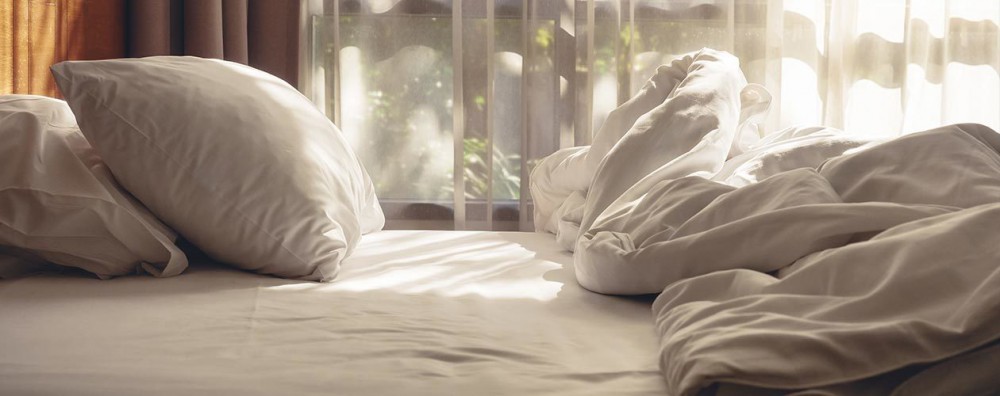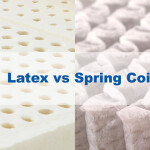How to Clean a Mattress
Most people like to lead a clean life. Some are less organized than others and fall into problems with clutter, but even these people understand the importance of clean bathrooms, kitchens and the like. But there is one space in our homes where even the most meticulous neat freak can neglect to clean.
data-ad-client="ca-pub-1542090382626399"
data-ad-slot="7742579998">
We spend a lot of our lives, about one-third of it, in bed. And while we may make sure to change sheets once a week and send comforters to the dry cleaners and even clean or replace our pillows frequently, many people don’t clean their mattresses.
Over time, mattresses can accumulate dirt, debris and microscopic organisms that can present a threat to our health. Mitigating these risks is easy, once you follow some of these simple methods for cleaning your mattress.
Before we dive into mattress hygiene, let’s explore the modern sleeping mattress so that we can more fully understand its construction.
Mattresses Can Be Made from Many Materials
A traditional mattress is made from foam cushioning and innersprings. These components give mattresses their comfort. A firm mattress will have tighter-wound coils and denser foam.
Memory foam mattresses can range from a simple single-layer block of foam to a multi-layer or hybrid approach, featuring inner springs at the base and modern foam components near the sleeping surface.
Also, there are latex mattresses, which provide firmer support. These latex mattresses also may have other benefits, such as from the use of natural materials.
The type of material used in your mattress may dictate the cleaning method. For example, if you get a latex mattress wet during the cleaning process, you will need to air dry the latex for a more extended period.
No matter the construction material, almost every mattress is covered with some sort of fabric. This layer is where all the dirt and grime accumulate over time. Some of the dirt can penetrate these layers, and liquid stains can also seep through, requiring a more-intensive cleaning process. But for the most part, mattress cleaning involves a focus on the top fabric layer.
Mattress Lifespan
Different materials last longer than others, but in general, mattresses last roughly 10 years before beginning to degrade in a way that negatively affects sleep quality. This period depends on several different factors. A lighter person who does little tossing and turning may see no difference in their mattress support and comfort after 15 or 20 years.
Someone heavier or who neglected the mattress over its lifetime may need a new one in five years. Some materials last longer than others, such as latex which is almost indestructible as a mattress material.
The decision to replace a mattress usually is not prompted by a complete failure of the product, but the search for something new. Sometimes, the inner support materials are in perfect shape, but the mattress top feels matted down and old.
Mattress Debris Can Get Gross
Since we spend so much time on our mattresses, it understandably can become a magnet for body filth. Body filth is as gross as it sounds. Sweat, skin cells, body oils, blood, urine and more can permeate sheets and barrage your mattress. When left to soak into your bedding, body filth causes stains, odor and can also matt down pillow tops and cushion layers.
Also, mattresses can become breeding grounds for dust mites, the tiny spider-like creatures that feed on dead skins cells. You won’t ever see these little monsters, but they can enter respiratory systems, causing allergic reactions, infections, rashes and more. The best way to minimize dust mite population is to take away their free buffet with regular cleaning.
How Cleaning Increases Mattress Life
Regular cleaning not only removes body filth and dust mites, but it is also the easiest way to extend your mattress’ longevity. Over time, humans produce a ton of body oil. Body oil can destroy mattress fibers. Stains are more than just unsightly, odor-producing and food for dust mites; they also make a mattress less comfortable.
The top protective layer of a mattress is the perimeter of comfort. Your mattress can be chock-full of the latest in comfort technology and innovations inside, but if the surface is matted down you won’t experience optimal sleep, and you’ll be looking for a replacement before truly necessary.
How A Clean Mattress Improves Health
Mattress cleaning also can help avoid health problems. A comfortable bed is crucial to a good night’s sleep, and rest is one of the most critical components of good health. Sleep improves both physical and mental wellness, helps fight illness, and can help people avoid fatigue-related injuries. Beyond some of these reasons, sleeping simply feels good. Who hasn’t worked a hard day to gleefully crawl into bed at night for escape from life’s hectic moments? Sleep is restorative on many levels, but a dirty mattress is an obstacle to the healthy rest that your body craves.
With all of the benefits of a clean mattress, from product longevity to health and happiness, what is the best way to go about the task? What about really bad stains? What if you haven’t ever cleaned your mattress, but want to reverse the accumulation of body filth? We have you covered. Here is how to tackle even the messiest mattress easily and inexpensively.
General Mattress Cleaning Tips
The first and easiest suggestion is to change your sheets and other bed coverings frequently. Everyone likes the feel of a fresh set of sheets. Since you ideally spend eight hours a day snuggled up to those sheets, treat yourself to that new sheet feeling as often as you can. A weekly sheet change is reasonable.
Obviously, this is a much easier project when you have multiple sheet sets. Schedule a time for doing this cleaning job each week. Launder your soiled sheets right away and have them folded and ready for the next week.
When you remove your sheets, take a good look at the mattress. Run a handheld vacuum over the surface to pick up any dander or debris. It’s not necessary to do a thorough mattress cleaning with every sheet change, but if you see a mess, picking it up now saves from a bigger job later.
Once a month, vacuum the mattress thoroughly, making sure to hit creases and other areas that might hide dirt. Examine the mattress for stains or signs of wear that might be caused by body oil. This might not be evident at first, so feel the mattress surface with your hands. If anything has a somewhat greasy feel, you will want to remove as much as you can.
Removing Body Oil
Body oil is essentially just like any other oil when it comes to mattress cleaning. As with any cleaning process, start with a dry approach. Vacuum the mattress as you would during a sheet change, then use a soft brush on areas that seem impregnated with body oil.
These areas might have attracted additional dry matter that resists vacuuming because of how oil can trap other loose debris. A soft brush will break up anything that has crusted into the mattress. Once brushed, run your vacuum back over the mattress to prepare the surface.
Hit up the baking supplies to soak up oil
Once you have identified your oil spots, sprinkle the area with baking soda or cornstarch. Both of these common household ingredients are cheap and effective ways to absorb and remove oil from any fabric. They work like how a paper towel quickly picks up wet messes —through capillary action. Capillary action is a phenomenon of chemistry and physics where a liquid seemingly defies gravity. The reason for this is when cohesion and adhesive forces lead the liquid into a small tube, or in the case of a paper towel, the cellulose cells in dry paper.
Be sparing with the use of baking soda and cornstarch. While cornstarch tends to attract more oil, baking soda is also an odor neutralizer. Whichever powder you choose, it’s preferable to use a small amount and apply more afterward if more oil is present. After sprinkling your home remedy on your mattress, let it sit for 30 minutes. Then, vacuum the powder or starch and check the surface for remaining oil. Repeat the process, including agitating the area with a soft brush.
Add a liquid for stubborn oil
If oil remains after this process, you will have to move to a wet cleaning method. Once you introduce water to your mattress, you must exercise caution. If you do not adequately dry the mattress after cleaning, you can cause mildew to form, which can be even worse than body oil for your health and your bed.
As with most home cleaning, start small and use the least invasive process first before bringing out the big guns. In other words, accumulated body oil does not require renting a steam carpet and upholstery cleaner. Instead, mix up a solution of vinegar and baking soda. You want this mixture to be thinner than a paste, but still relatively thick.
A combination of 1 cup of baking soda to 2 cups of water is a good ratio. If desired, you can add a drop or two of essential oil. This helps neutralize both the vinegar smell and any lingering odors on the mattress.
Mix well in a cleaning bucket, and apply the cleaning paste with a large sponge to the entire mattress surface. Pay extra attention to areas with set in body oil. Let dry for one hour. With a clean sponge and clear water, wipe the baking soda solution — there likely will be some dried baking soda on the mattress at this point. You will then have to wait for any dampness to dry before putting on clean sheets and bedding.
Dealing With Tougher Stains
What if there are stains other than from body oil? In this case, the process will be much the same, except for a few types of stubborn stains. Most body stains clear up with the baking soda and vinegar method, but blood is a special case. Starting with the least invasive process first, try to flake off any dried blood with a small stiff brush.
An old toothbrush works well. If the stiff brush doesn’t work, try using a plastic scraper or an old credit card. Vacuum up any dried blood before moving to any wet cleaning method.
Similar to using baking powder or cornstarch, you can mix up a paste of water and meat tenderizer to make an effective blood stain remover. The active chemical in most commercial meat tenderizers is bromelain, an extract from pineapple. Why does meat tenderizer work? It is an enzyme that reduces blood clotting, and when mixed with water, it can rehydrate dried blood, allowing for easy stain extraction. Just apply the tenderizer paste to the blood stain, let sit for 30 to 90 minutes, then wipe away with a clean wet sponge or rag.
When All Else Fails
If you’ve tried these cheaper, natural, and most of the time highly effective solutions to remove mattress stains to no avail, then, by all means, look into more aggressive solutions. Most supermarkets have an extensive selection of commercial stain removing products. Look at laundry stain removers as well, since your mattress cover is like a large article of laundry that you just cannot fit into your washer machine.
Again, be cautious as over applying any cleaning product risks sending the liquid into the center of the mattress, where it can potentially damage foam and inner support materials.
A rentable commercial steam cleaner is also an option that will power wash your mattress. If you are going to attempt this method, it’s best to do so when you can ensure that your bed will dry quickly, such as on a warm sunny day. Steam cleaners are intended for use on carpets and upholstery.
The units use very hot water mixed with a low-foam detergent, which is forced through the fabric. Then, an extractor tool, which is like a combination of a squeegee and a vacuum, is used to pull as much of the cleaning fluid back out of the fabric.
Special Concerns With Memory Foam and Latex
The above cleaning methods are appropriate for a traditional innerspring mattress. Today, with bed-in-a-box solutions becoming increasingly popular, you might not have a conventional mattress. While the fabric cover may be similar, you should be extra cautious to avoid getting the foam wet with water, vinegar or a cleaning solution. Before cleaning a memory foam or latex mattress, consult with the manufacturer’s recommended cleaning steps.
These methods are likely going to follow our general rule of taking the most straightforward step first. Vacuum the mattress, then if there are stains present, use a spot-cleaning method to target the stains rather than risk ruining the entire mattress. A useful spot-cleaning solution is a one to one ratio of warm water and laundry or mild dish detergent.
If you get your memory foam or latex mattress wet when cleaning, it’s crucial to air dry completely. If you can, drag the mattress to a clean spot outside and allow it to dry in the sun.
What About Dreaded Bedbugs?
Most of our cleaning tips here have been focused on typical, run of the mill bedroom messes. Bedbugs are another potential mattress problem that requires a different plan of attack. Bedbugs are small flat insects with segmented bodies. They feed on human blood, often hiding in a crevice or recessed area in your mattress, bed frame or another piece of furniture. At night while you sleep, they will come to eat, and you’ll wake up in the morning covered in painful itchy bites.
The first step in alleviating bedbugs is identification. Remove sheets and inspect the mattress. If you see reddish-brown flecks that look a bit like coffee grounds, bingo, you probably have bedbugs. The coffee ground-looking specks are the bedbug’s excrement. To find the bugs, look in the folds of mattresses. If they aren’t anywhere to be found, they are probably lurking someplace under your bed frame.
Bedbugs are pretty severe problems to have, so you are likely going to need the help of a professional. While you are waiting for an exterminator to eliminate your infestation, you can vacuum up any bugs, and wash bed linens on the hottest water setting. The exterminator will let you know if your mattress is toast.
Prevent (Most) Cleaning Problems With a Mattress Cover
Lastly, one of the best ways to avoid a dirty mattress other than regular cleaning is to invest in a mattress cover. With a mattress cover, not only will body soil not reach the mattress surface, but spills and liquids will also hit a protective barrier. Mattress covers have come a long way since their use as rubber sheets for children. Now, they not only protect against stains, but they also can provide an extra layer of comfort.
Change your sheets often, vacuum your mattress once a month, and clean up stains as soon as possible. With regular cleaning, you can enjoy your mattress for many years.
data-ad-client="ca-pub-1542090382626399"
data-ad-slot="7155901418"
data-ad-format="auto">

Source: Internet





